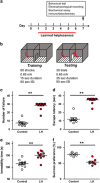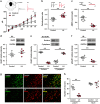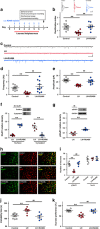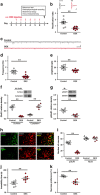Periaqueductal Gray Glutamatergic Transmission Governs Chronic Stress-Induced Depression
- PMID: 28853438
- PMCID: PMC5729570
- DOI: 10.1038/npp.2017.199
Periaqueductal Gray Glutamatergic Transmission Governs Chronic Stress-Induced Depression
Abstract
The mechanisms underlying chronic stress-induced dysfunction of glutamatergic transmission that contribute to helplessness-associated depressive disorder are unknown. We investigated the relationship of α-amino-3-hydroxy-5-methyl-4-isoxazolepropionic acid (AMPA) receptors and stress, and the neuroplastic changes of stress-induced depression-like behavior in the ventrolateral periaqueductal gray (vlPAG). We conducted whole-cell patch-clamp electrophysiological recordings in the vlPAG neurons. Depression-like behavior was assayed using tail suspension test and sucrose preference test. Surface and cytosolic glutamate receptor 1 (GluR1) AMPA receptor expression was analyzed using western blotting. Phosphorylated GluR1 expression was quantified using western blotting and immunohistochemical analysis. Unpredictable inescapable foot shock stress caused reduction in glutamatergic transmission originating from both presynaptic and postsynaptic loci in the vlPAG that was associated with behavioral despair and anhedonia in chronic stress-induced depression. Pharmacological inhibition of GluR1 function in the vlPAG caused depression-like behavior. Diminished glutamatergic transmission was due to reduced glutamate release presynaptically and enhanced GluR1-endocytosis from the cell surface postsynaptically. Chronic stress-induced neuroplastic changes and maladaptive behavior were reversed and mimicked by administration of glucocorticoid receptor (GR) antagonist and agonist, respectively. However, chronic stress did not affect γ-aminobutyric acid (GABA)-mediated inhibitory synaptic transmission in the vlPAG. These results demonstrate that depression-like behavior is associated with remarkable reduction in glutamatergic, but not GABAergic, transmission in the vlPAG. These neuroplastic changes and maladaptive behavior are attributed to GR-dependent mechanisms. As reduced GluR1-associated responses in the vlPAG contribute to chronic stress-induced neuroplastic changes, this cellular mechanism may be a critical component in the pathogenesis of stress-associated neuropsychiatric disorders.
Figures





Similar articles
-
(2R,6R)-hydroxynorketamine rescues chronic stress-induced depression-like behavior through its actions in the midbrain periaqueductal gray.Neuropharmacology. 2018 Sep 1;139:1-12. doi: 10.1016/j.neuropharm.2018.06.033. Epub 2018 Jun 25. Neuropharmacology. 2018. PMID: 29953886
-
NMDA receptor partial agonist GLYX-13 alleviates chronic stress-induced depression-like behavior through enhancement of AMPA receptor function in the periaqueductal gray.Neuropharmacology. 2020 Nov 1;178:108269. doi: 10.1016/j.neuropharm.2020.108269. Epub 2020 Aug 10. Neuropharmacology. 2020. PMID: 32791085
-
Periaqueductal gray is required for controlling chronic stress-induced depression-like behavior.Biochem Biophys Res Commun. 2022 Feb 19;593:28-34. doi: 10.1016/j.bbrc.2022.01.025. Epub 2022 Jan 11. Biochem Biophys Res Commun. 2022. PMID: 35051779
-
The dose makes the poison: from glutamate-mediated neurogenesis to neuronal atrophy and depression.Rev Neurosci. 2016 Aug 1;27(6):599-622. doi: 10.1515/revneuro-2015-0066. Rev Neurosci. 2016. PMID: 27096778 Review.
-
Impaired glutamatergic synaptic transmission in the PKU brain.Mol Genet Metab. 2005 Dec;86 Suppl 1:S34-42. doi: 10.1016/j.ymgme.2005.06.014. Epub 2005 Sep 8. Mol Genet Metab. 2005. PMID: 16153867 Review.
Cited by
-
Circuit-Based Biomarkers for Mood and Anxiety Disorders.Trends Neurosci. 2020 Nov;43(11):902-915. doi: 10.1016/j.tins.2020.08.004. Epub 2020 Sep 8. Trends Neurosci. 2020. PMID: 32917408 Free PMC article. Review.
-
(2R,6R)-hydroxynorketamine rapidly potentiates hippocampal glutamatergic transmission through a synapse-specific presynaptic mechanism.Neuropsychopharmacology. 2020 Jan;45(2):426-436. doi: 10.1038/s41386-019-0443-3. Epub 2019 Jun 19. Neuropsychopharmacology. 2020. PMID: 31216563 Free PMC article.
-
Defensive and Emotional Behavior Modulation by Serotonin in the Periaqueductal Gray.Cell Mol Neurobiol. 2023 May;43(4):1453-1468. doi: 10.1007/s10571-022-01262-z. Epub 2022 Jul 28. Cell Mol Neurobiol. 2023. PMID: 35902460 Free PMC article. Review.
-
The interrelationship of chronic cough and depression: a prospective population-based study.ERJ Open Res. 2022 Apr 4;8(2):00069-2022. doi: 10.1183/23120541.00069-2022. eCollection 2022 Apr. ERJ Open Res. 2022. PMID: 35402604 Free PMC article.
-
Neurobiology of Depression: Chronic Stress Alters the Glutamatergic System in the Brain-Focusing on AMPA Receptor.Biomedicines. 2022 Apr 27;10(5):1005. doi: 10.3390/biomedicines10051005. Biomedicines. 2022. PMID: 35625742 Free PMC article. Review.
References
-
- Auer DP, Putz B, Kraft E, Lipinski B, Schill J, Holsboer F (2000). Reduced glutamate in the anterior cingulate cortex in depression: an in vivo proton magnetic resonance spectroscopy study. Biol Psychiatry 47: 305–313. - PubMed
-
- Berton O, Covington HE 3rd, Ebner K, Tsankova NM, Carle TL, Ulery P et al (2007). Induction of deltaFosB in the periaqueductal gray by stress promotes active coping responses. Neuron 55: 289–300. - PubMed
MeSH terms
Substances
LinkOut - more resources
Full Text Sources
Other Literature Sources
Medical
Research Materials

